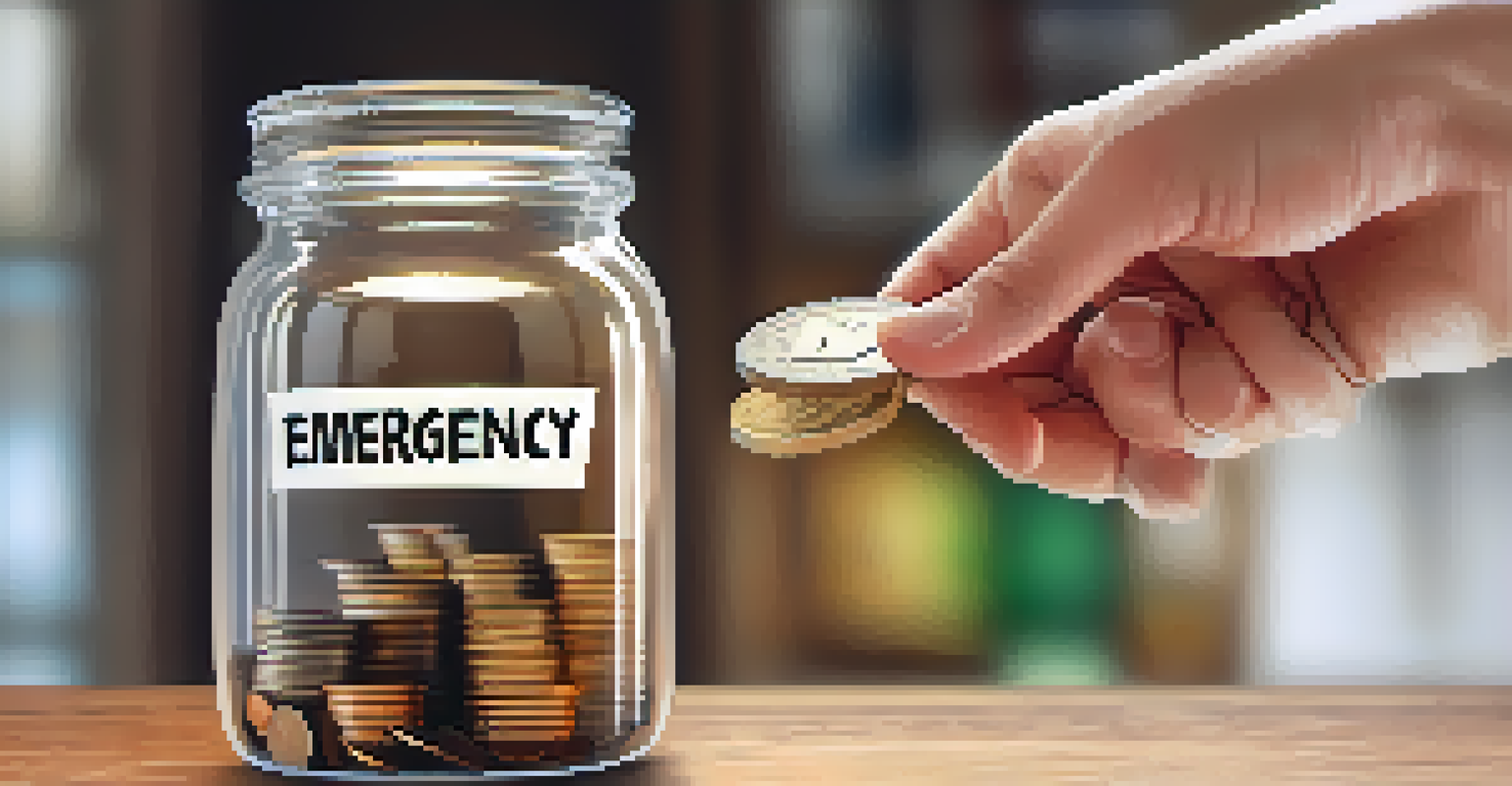When to Use Your Emergency Fund: Guidelines to Follow

Understanding the Purpose of an Emergency Fund
An emergency fund is your financial safety net, designed to cover unexpected expenses. Think of it as a buffer between you and life's inevitable surprises, like medical bills or car repairs. This fund is separate from your regular savings and is specifically for emergencies only.
An investment in knowledge pays the best interest.
Having this fund allows you to tackle unforeseen events without derailing your financial stability. For instance, if your car breaks down and needs costly repairs, your emergency fund can step in to save the day. This way, you won’t have to rely on credit cards or loans, preserving your long-term financial health.
Ultimately, understanding the purpose of your emergency fund is crucial. It’s not just about having money set aside; it’s about empowering yourself to handle life’s curveballs with confidence.
When to Dip Into Your Emergency Fund
The key to using your emergency fund lies in knowing what qualifies as an emergency. Generally, this includes situations like sudden job loss, unexpected medical expenses, or urgent home repairs. Each of these scenarios can place significant strain on your finances, making your emergency fund a vital resource.

For example, if you lose your job, accessing your emergency fund can help cover living costs while you search for new employment. Similarly, if a pipe bursts in your home, using these funds can prevent further damage and costly repairs. Understanding these situations helps ensure you use your fund wisely.
Emergency Fund Basics
An emergency fund is a financial safety net designed to cover unexpected expenses, providing peace of mind and financial stability.
In essence, reserve your emergency fund for true emergencies. This way, you’ll avoid depleting it on non-essential expenses, ensuring it’s available when you really need it.
Avoiding Common Misuses of Emergency Funds
One of the biggest pitfalls is using your emergency fund for non-emergencies, like a vacation or a new gadget. While these purchases may feel justifiable at the moment, they can undermine the very purpose of your fund. Think of it as borrowing from your future self, which can lead to financial stress later on.
The best way to predict your future is to create it.
Another common misuse is tapping into the fund for regular expenses, such as monthly bills or groceries. These costs should be covered by your regular income, not your emergency savings. By distinguishing between needs and wants, you can help protect your emergency fund for its intended purpose.
To maintain the integrity of your emergency fund, set clear boundaries for its use. This will not only help you avoid unnecessary withdrawals but also ensure that your fund remains intact for true emergencies.
Replenishing Your Emergency Fund After Use
Once you've used your emergency fund, replenishing it should be a top priority. Life is unpredictable, and you want to be prepared for the next unexpected expense. Consider setting aside a portion of your monthly income until you've restored the fund to its original level.
For example, if you had to withdraw $2,000 for an emergency, create a plan to contribute an extra $200 each month for ten months. This way, you can rebuild your safety net without feeling overwhelmed. It's a manageable approach that keeps your financial goals on track.
Smart Usage of Emergency Funds
It's crucial to reserve your emergency fund for true emergencies like job loss or urgent repairs, avoiding its depletion on non-essential purchases.
In essence, think of replenishing your fund as a commitment to yourself. It’s about ensuring that you’re always ready for whatever life throws your way, maintaining peace of mind.
Setting Realistic Emergency Fund Goals
Having a clear goal for your emergency fund can help keep you motivated. A common guideline is to aim for three to six months’ worth of living expenses. This amount provides a comfortable cushion to navigate unexpected financial turbulence.
To establish your specific goal, start by calculating your monthly expenses. Then, multiply that number by three or six, depending on your comfort level. This figure will give you a tangible target to work towards, making your savings journey feel more achievable.
Ultimately, setting realistic goals allows you to build your fund at a pace that suits your lifestyle. Remember, it’s about progress, not perfection, so celebrate each milestone along the way.
Reviewing and Adjusting Your Emergency Fund Regularly
Life changes, and so should your emergency fund. Regularly reviewing your savings can help ensure it remains adequate for your current situation. Factors like a new job, increased expenses, or changes in family size may all influence how much you need set aside.
Consider scheduling a financial check-in every six months to assess your emergency fund. During these reviews, evaluate your expenses and adjust your savings target accordingly. This proactive approach helps keep your finances aligned with your life’s changes.
Regular Fund Reviews
Regularly reviewing and adjusting your emergency fund ensures it remains adequate for your current life circumstances and financial needs.
In summary, regular adjustments to your emergency fund can enhance your financial resilience. By staying attuned to your needs, you’ll ensure that your safety net is always ready to catch you.
The Psychological Benefits of an Emergency Fund
Beyond the financial aspect, having an emergency fund can provide significant psychological benefits. Knowing you have a safety net can reduce anxiety and stress, allowing you to focus on other areas of your life. It’s like having a comforting blanket that helps you feel secure amidst financial uncertainties.
For many, this peace of mind can lead to better decision-making. When faced with unexpected challenges, you’ll be less likely to panic and more inclined to think through your options. This clarity can ultimately lead to more effective solutions and a healthier relationship with money.

In conclusion, an emergency fund is not just about the dollars and cents; it’s about the emotional security it brings. By investing in your fund, you're investing in your overall well-being.